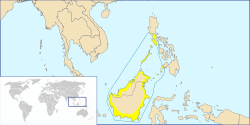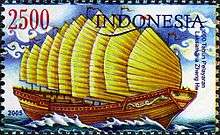Islam in the Philippines

Islam is the oldest recorded monotheistic religion in the Philippines. Islam reached the Philippines in the 14th century with the arrival of Muslim traders from the Persian Gulf, Southern India, and their followers from several sultanate governments in the Malay Archipelago. The Muslim population of the Philippines has been reported as about 5% of the total population as of a census in 2000.[1] According to the recent estimation conducted by the National Commission of Muslim Filipinos (NCMF), 11% of Filipinos are Muslims.[2] While the majority of the population are Roman Catholic, some ethnic groups are Hindu, Buddhist, Animist, Protestants, Sikhs and non-religious.
History
In 1380 Karim ul' Makhdum the first Arabian trader reached the Sulu Archipelago and Jolo in the Philippines and through trade throughout the island established Islam in the country. In 1390 the Minangkabau's Prince Rajah Baguinda and his followers preached Islam on the islands.[3] The Sheik Karimal Makdum Mosque was the first mosque established in the Philippines on Simunul in Mindanao in the 14th century. Subsequent settlements by Arab missionaries traveling to Malaysia and Indonesia helped strengthen Islam in the Philippines and each settlement was governed by a Datu, Rajah and a Sultan. Islam was introduced by Chinese Muslims, Indian Muslims, and Persians. Islamic provinces founded in the Philippines included the Sultanate of Maguindanao, Sultanate of Sulu, Sultanate of Lanao and other parts of the southern Philippines.
When the Spanish fleet led by Miguel López de Legazpi arrived in the Philippines in 1565, they were met by local datus as they traveled in the islands. Arriving in the Kingdom of Maynila, a vassal-state of the Sultanate of Brunei, in 1570 they were met by the Muslim rajah, Rajah Sulaiman III.
By the next century conquests had reached the Sulu islands in the southern tip of the Philippines where the population was Buddhist and Hinduand they took up the task of converting the animistic population to Islam with renewed zeal. By the 15th century, half of Luzon (Northern Philippines) and the islands of Mindanao in the south had become subject to the various Muslim sultanates of Borneo and much of the population in the almost of South were converted to Islam. However, the Visayas was largely dominated by Hindu-Buddhist societies led by rajahs and datus who strongly resisted Islam. One reason could be due to the economic and political disasters prehispanic Muslim pirates from the Mindanao region bring during raids. These frequent attacks gave way to naming present-day Cebu as then-Sugbo or scorched earth which was a defensive technique implemented by the Visayans so the pirates have nothing much to loot.[4][5]
Invasion of Bruneian Sultanate
In the year 1498-99, the Bruneian Empire conducted a series of raids against the natives of the Kingdom of Taytay in Palawan and the island of Mindoro which had been subjugated to the Islamic Bruniean Empire under Sultan Bolkiah. The Muslim conquest reached as far as the Kingdom of Tondo which was supplanted by Brunei's vassal-state the Kingdom of Maynila.[6][7]
Before they reached the shores of Luzon, they subjugated the Buddhist Huangdom of Mai and that lead to its decline. The Buddhist culture of Mindoro gradually disappeared after Bolkiah forced the citizens of Mai to converted their faith to Islam. They forcibly converted and conquered people up to the fall of the Kingdom of Tondo.

The Muslim Bruneian Empire under the rule of Sultan Bolkiah, who is an ancestor of the current Sultan of Brunei. He subjugated the Kingdom of Tondo which is ruled by Rajah Gambang during 1500. The aftermath of the battle was the formation of an alliance between the newly established Kingdom of Maynila (Selurong) and the Sultanate of Brunei, to crush the power of the Kingdom of Tondo and the subsequent installation of the Pro-Islamic Rajah Sulaiman into power. Furthermore, Sultan Bolkiah's victory over Sulu and Seludong (modern day Manila),[8] as well as his marriages to Laila Mecanai the daughter of Sulu Sultan Amir Ul-Ombra (an uncle of Sharifa Mahandun married to Nakhoda Angging or Maharaja Anddin of Sulu), and to the daughter of Datu Kemin, widened Brunei's influence in the Philippines.[9]
A new dynasty under the a local Lumad leader who accepted Islam and became Rajah Salalila or Rajah Sulayman I. He also started to established a trading challenge the already rich House of Rajah Lakandula in Tondo. Islam was further strengthened by the arrival of Muslim traders and from Jolo, Mindanao, Malaysia and Indonesia.[10]
Islamization by forced conversion to the citizens of Tondo and Manila make the divisions into Muslim domains and installed Rajah Suleyman and Rajah Matanda in the south (now the Intramuros district) and the Buddhist-Hindu settlement under Raja Lakandula in northern Tundun (now Tondo.)[11] With the rise of Islam, other religions in the archipelago gradually disappeared.
- note: Rajah is a Hindu title and Sultan is an Islamic title for that era.
Influences of Zheng He's voyages
Chinese mariner Zheng He is credited to have settled Chinese Muslim communities in Palembang and along the shores of Java, the Malay Peninsula, and the Philippines during China's early Ming dynasty. These Muslims allegedly followed the Hanafi school in the Chinese language.[12] This Chinese Muslim community was led by Hajji Yan Ying Yu, who urged his followers to assimilate and take local names.
Spanish encounter
Rajah Sulayman was the Muslim Rajah of Maynila, a kingdom at the mouth of the Pasig River where it meets Manila Bay, at the time the Spanish forces first came to Luzon.[13][14][15]
Sulayman resisted the Spanish forces, and thus, along with Rajah Matanda and Lakan Dula, was one of three Rajahs who played significant roles in what was the Spanish conquest of their kingdoms of the Pasig River delta in the early 1570s.[16]
Moro (derived from the Spanish word meaning Moors) is the appellation inherited from the Spaniards, for Filipino Muslims of Mindanao. The Moros seek to establish an independent Islamic province in Mindanao to be named Bangsamoro. The term Bangsamoro is a combination of an Old Malay word meaning nation or state with the Spanish word Moro which means Muslim. A significant Moro Rebellion occurred during the Philippine–American War. Conflicts and rebellion have continued in the Philippines from the pre-colonial period up to the present. Other related issue with the Moro secession is the territorial dispute of eastern Sabah in Malaysia which claimed by the Sultanate of Sulu as their territory.
The Moros have a history of resistance against Spanish, American, and Japanese rule for over 400 years. The violent armed struggle against the Japanese, Filipinos, Spanish, and Americans is considered by current Moro (Muslim) leaders as part of the four centuries long "national liberation movement" of the Bangsamoro (Muslim Nation).[17] The 400-year-long resistance against the Japanese, Americans, and Spanish by the Moro Muslims persisted and morphed into their current war for independence against the Philippine state.[18]
There is also a growing community of Filipino converts to Islam known popularly as Balik Islam (return or returnees to Islam), often led by former Christian missionary converts.[19][20][21][22]
Muslim Mindanao
Most of Muslims in the Philippines live on the island of Mindanao, the Sulu Archipelago and Palawan. The Autonomous Region in Muslim Mindanao (ARMM) is the region of the Philippines that is composed of all the Philippines' predominantly Muslim provinces, namely: Basilan (except Isabela City), Lanao del Sur, Maguindanao, Sulu and Tawi-Tawi, and the Islamic City of Marawi. It is the only region that has its own government. The regional capital is at Cotabato City, although this city is outside of its jurisdiction.
Other provinces and regions with large Muslim populations, as well as a significant history with Moro Muslims include North Cotabato, South Cotabato, Sultan Kudarat and the Zamboanga Peninsula. However, these are not part of the ARMM.
Indigenous Tribal art from the Philippines
-
An Indigenous Tribal "Food jar" also known as gadur, well known for its brass with silver inlay.
-
A Chest made of wood and bone inlay.
-
%2C_Mindanao%2C_wood%2C_Honolulu_Museum_of_Art.jpg)
Lute also known as kutyapi.
-
Saddle panel, wood with shell inlay.
-
Saddle panel, wood with shell inlay.
-
Jaw harp handle, horn with brass studs.
See also
References
- ↑ "International Religious Freedom Report for 2014". United States Department of State, Bureau of Democracy, Human Rights and Labor. Retrieved 21 February 2016.
- ↑ http://www.ncmf.gov.ph/
- ↑ "Kerinduan orang-orang moro". TEMPO- Majalah Berita Mingguan. Retrieved June 23, 1990. Check date values in:
|access-date=(help) - ↑ "A Rapid Journal Article Volume 10, No. 2". Celestino C. Macachor. Retrieved August 11, 2012.
- ↑ "The Aginid". Maria Eleanor Elape Valeros. Retrieved August 11, 2012.
- ↑
- Scott, William Henry (1994). Barangay: Sixteenth Century Philippine Culture and Society. Quezon City: Ateneo de Manila University Press. ISBN 971-550-135-4.
- ↑ del Mundo, Clodualdo (September 20, 1999). "Ako'y Si Ragam (I am Ragam)". Diwang Kayumanggi. Archived from the original on October 25, 2009. Retrieved 2008-09-30.
- ↑ History for Brunei 2009, p. 41
- ↑ "Brunei". CIA World Factbook. 2011. Retrieved 13 January 2011.
- ↑ Agoncillo, Teodoro A. (1990). History of the Filipino People (8th ed.). Garotech Publishing. p. 22. ISBN 971-8711-06-6.
- ↑ Teodoro Agoncillo, History of the Filipino People, p 22
- ↑ AQSHA, DARUL (13 July 2010). "Zheng He and Islam in Southeast Asia". The Brunei Times. Retrieved 28 September 2012.
- ↑ Joaqiun, Nick (1990). Manila, My Manila: A History for the Young. City of Manila: Anvil Publishing, Inc. ISBN 978-971-569-313-4.
- ↑ Scott, William Henry (1994). Barangay: Sixteenth Century Philippine Culture and Society. Quezon City: Ateneo de Manila University Press. ISBN 971-550-135-4.
- ↑ Dery, Luis Camara (2001). A History of the Inarticulate. Quezon City: New Day Publishers. ISBN 971-10-1069-0.
- ↑ 222. "Rajah Soliman". National Heroes. Globalpinoy.com. Retrieved February 5, 2008.
- ↑ Banlaoi 2012, p. 24.
- ↑ Banlaoi 2005, p. 68.
- ↑ Eliza Griswold (2011). The Tenth Parallel: Dispatches from the Faultline Between Christianity and Islam. Penguin UK. pp. 258–261. ISBN 9781846144226.
- ↑ Mathieu Guidère (2012). Historical Dictionary of Islamic Fundamentalism (illustrated ed.). Scarecrow Press. p. 50. ISBN 9780810878211.
- ↑ William Larousse (2001). A Local Church Living for Dialogue: Muslim-Christian Relations in Mindanao-Sulu, Philippines : 1965-2000 (illustrated ed.). Gregorian Biblical BookShop. pp. 185, 188–190. ISBN 9788876528798.
- ↑ Ramona Ruiz (9 July 2014). "Prominent Filipino Muslim preachers to discuss Islam at Dubai World Trade Centre". The National. Retrieved 17 February 2016.
External links
- Bangsamoro
- Filipino Muslim
- Fil-Mus Foundation
- Islam and Muslims in the Philippines
- National Commission on Muslim Filipinos The National Commission on Muslim Filipinos is a government agency whose objective is to promote the rights of Muslim Filipinos and to make them active participants in Philippine nation-building.

